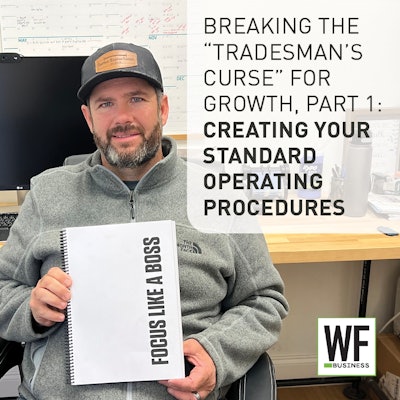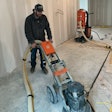
In the October/November 2023 issue of Wood Floor Business I laid out the groundwork of the steps I’ve been taking to break the “tradesman’s curse” for growth and shared a little bit about how it’s transforming my company, a small wood flooring contractor/retailer in the small market of San Angelo, Texas. In this series of blog posts, I’m going to take a deeper dive into each aspect of that groundwork.
Creating a solid business structure can feel like an overwhelming undertaking. I admit this topic can seem boring, but I can get excited about a business that can run on its own! This won’t happen unless there are great SOP’s (standard operating procedures) for the team.
It’s important to keep in mind that this is something that will continually improve. It’s a living document of systems and processes. Even if it’s not perfect, it’s probably better than what you started with and can always be improved upon. I actually took on this blogging series to look deeper into our SOP’s to think of ways we can improve, be more efficient, and provide a better experience for our staff and our clients alike!
The easiest way for me to think about how the operating system of my business should work is the natural progression of the work flow. We start with how we get the lead, we sell products and services to the client, we procure the products and provide the services, we finalize the project and collect final payment. We document the most efficient system for each stage that is cohesive for the next stage and create a digital information retrieval system to reduce bottlenecks and provide accountability. A good customer relationship management system (CRM) will help the process.
A system is the structure or framework, and the process is how to get the work done. When the team can understand processes and how they are integrated into the company systems, they will be empowered to hit goals personally and for the company as a whole. The company staff can utilize this information as an outline to produce the company SOP’s, so it’s not all on one person. They will have more buy-in if they help create it!
Let’s break down the work flow:
1) The Lead
When we define our SOP’s for lead generation, we have the opportunity to prioritize what kind of marketing and branding strategies produce the best results, along with other types of marketing and branding that could fuel future growth of the business.
Critical action steps:
1. Define and prioritize the marketing strategy. Think outside the box!
2. List every step to complete each task. Develop checklists for each task—your team will thank you!
3. Track and document (this will help you strategize).
2) The Sale
What is your sales process? The main components of the sale are: initial contact, service and/or product selection, estimate/site evaluation, closing the deal, and procuring materials.
Critical action steps:
1. Document steps and procedure for initial contact. Get creative!
2. Develop a sales presentation and process for RSA’s (retail sales associate). Make it a fun experience for the clients and RSA’s!
3. Document all the steps necessary to complete the on-site estimate and site evaluation. Remember, this opportunity to be in the home or building is also an opportunity to get the client excited about interior design and how beautiful their project is going to be.
4. Develop a process to close the deal. This can include how to ask for the sale and a followup procedure. This step is where the rubber meets the road; make this process smooth and to the point!
5. Evaluate your process for material procurement, list all the steps so there are few mistakes and no confusion in the process.
6. Create checklists for each stage of the sales process so the team can quickly verify they are working within the company SOP’s; this provides accountability.
7. All this information needs to be in a digital information retrieval system so anyone who needs access to any of the sales information can access it easily without creating information bottlenecks. There are many apps and software solutions that can make this happen.
3) Project Services
This is when the sales team works with the field technicians to complete the project.
Critical action steps:
1. Document all steps necessary to create a work order that is thorough and complete. We want the service portion of the project to run as smooth as possible!
2. List a process for inventory, materials management, and delivery. Dialing in this process can set the service portion of the project off to a great start.
3. Field technicians need company SOP’s documented and all expectations in writing. This is a very important stage; make it an awesome experience for the team and client!
4) Project Wrapup
The final stage of the project is to collect final payment and set up the post-project opportunities.
Critical action steps:
1. List all steps necessary to wrap up the project and collect final payment. A happy client will be much more likely to pay promptly and in full!
2. Make a list of post-project opportunities and organize them in SOP’s. This can include care packages, requests for reviews, and maintenance packages.
Conclusion
The work you do here will become the handbook of SOP’s that will guide your team to hit its full potential! It won’t happen overnight, and you will add more to it over time for upper level management, HR, etc., but this will help build a healthy foundation for any business, no matter how small or big. Always keep in mind that this is an investment into the success of the company and for the personal success of every team member, because a thriving team is a winning team!
Stay tuned for Part 2 of our blog series, Project Analysis! We will do a deep dive into job costing and profit margins.
Editor's Note:
Be sure to read the WFB Magazine article “Building Systems to Break the ‘Tradesman’s Curse’ for Growth in Your Wood Flooring Business” and all of Matt's blog posts in this series:
Breaking the “Tradesman’s Curse” for Growth, Part 1: Creating Your Standard Operating Procedures
Breaking the 'Tradesman’s Curse' for Growth, Part 2: Project Analysis
Breaking the 'Tradesman’s Curse' for Growth, Part 3: Setting Quality Standards
Breaking the 'Tradesman’s Curse' for Growth, Part 4: Key Performance Indicators
Breaking the 'Tradesman’s Curse' for Growth, Part 5: Employee Scorecards
Breaking the 'Tradesman’s Curse' for Growth, Part 6: Performance Pay
Breaking the 'Tradesman’s Curse' for Growth, Part 7: The Power of Cash Flow
Straight from my treehouse, here are some of my thoughts about creating your standard operating procedures:
































